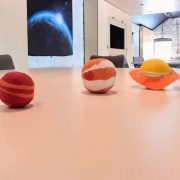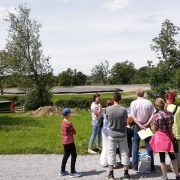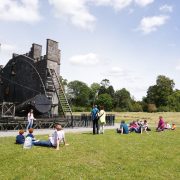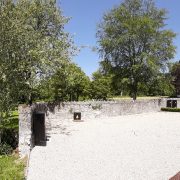Summer Internship Programme with I-LOFAR
/in blog, Education, focus_item, News /by Áine FloodWould you like to spend the summer working at a world-class radio telescope located in the beautiful historical setting of Birr Castle Demesne? Do you want a chance to improve your communication skills and learn how to talk engagingly about the subjects you are passionate about?
If so, the I-LOFAR Summer Internship is for you!
The successful candidates will be working closely with our I-LOFAR Education and Public Engagement Manager at the I-LOFAR site in Birr Castle Demesne, Co Offaly. They will assist in various aspects of the Education and Public Engagement programme, including giving guided tours, designing and facilitating workshops, creating social media and website content, and will also have the opportunity to take observations with the I-LOFAR telescope and work with the wider LOFAR research team. They will draw on their knowledge of physics, specifically astrophysics and radio astronomy, to engage with a wide range of visitors to the I-LOFAR Education Centre and through online channels.
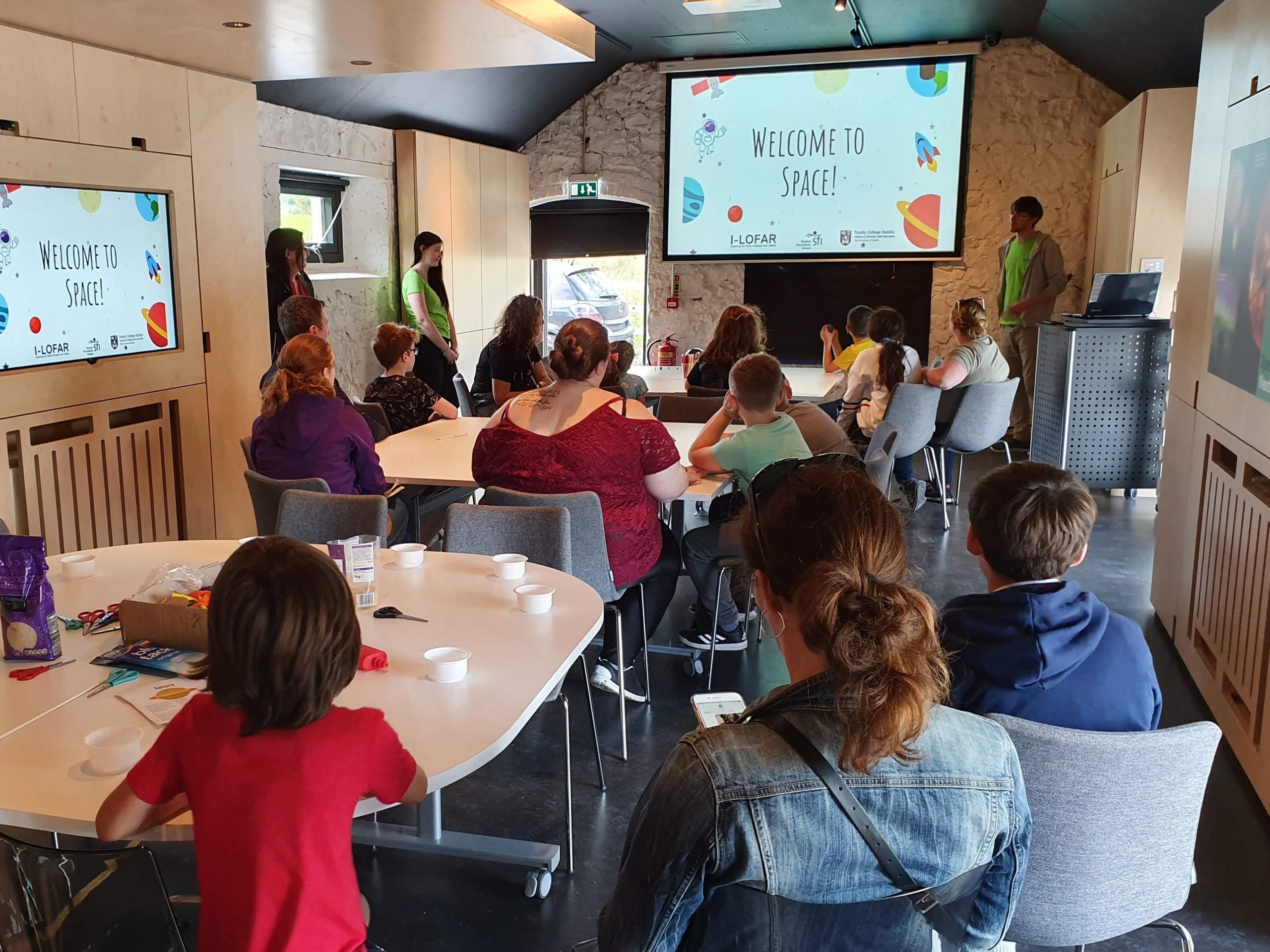
2019 I-LOFAR Summer Interns running a space workshop for children

Astronomy in Birr Tours include the Leviathan Telescope
This is a 12 week placement with Trinity College Dublin School of Physics and I-LOFAR, running from June to August 2020 (specific dates TBD), with a stipend of €300 per week.
To apply, please send your CV (max 2 pages), a cover letter, a letter of support from your degree course director confirming your registration in the degree and one letter of reference to education@lofar.ie no later than Friday 20th of March.
For any questions or queries about this role, please contact I-LOFAR Education and Public Engagement Manager Áine Flood at aine.flood@tcd.ie.
The I-LOFAR Summer Internship Programme is made possible thanks to support from the Science Foundation Ireland Discover Programme and ESERO Ireland. This is open to second and third year undergraduate students registered at Irish third level institutions. Applications will be accepted from students of physics, astrophysics and related disciplines.
NOTE: This position is based at the I-LOFAR Education Centre in Birr Castle Demesne, Birr, Co Offaly.



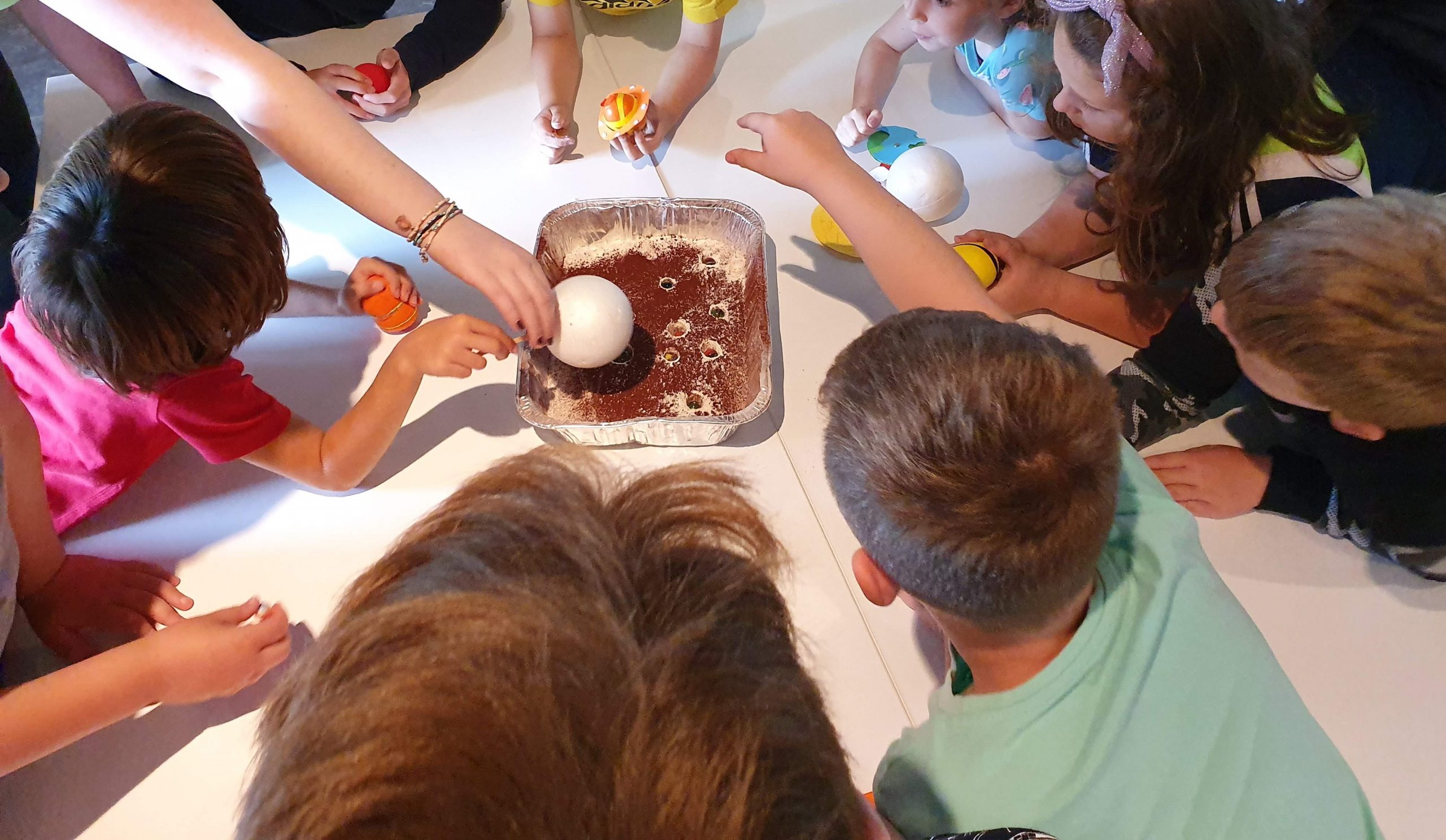
Exploring how craters are formed on the Moon
A New Perspective on I-LOFAR
/in blog, Education, News /by Áine FloodThis Guest Blog was written by a local secondary school student in Birr who came to visit I-LOFAR and has plans to study Physics at Third Level.
Hello, I’m Joshua, a sixth-year student of St. Brendan’s Community School Birr. I was recently given the opportunity to avail of a tour of I-LOFAR (the Irish Low Frequency Array). This tour was led by the Head of I-LOFAR, Prof. Peter Gallagher, and the Education and Public Engagement Manager, Áine Flood. On this tour I learned about the fascinating ways in which I-LOFAR works and what it does to broaden the frontiers of science.
What is LOFAR?
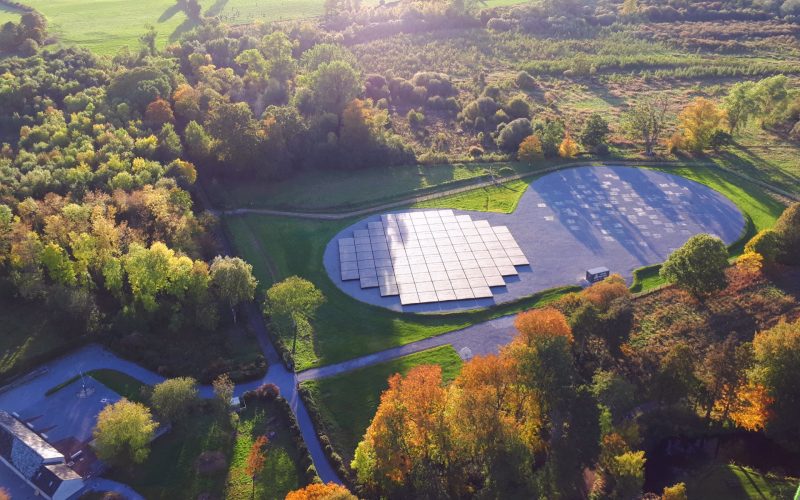
I-LOFAR Telescope viewed from the air. Credit: Alison Delaney, Birr Castle
At first glance, the above collection of boxes and antennas may not even resemble a simple telescope, never mind being capable of observing the universe as it was billions of years ago. But the Irish Low Frequency Array is a radio telescope. It detects radio waves, which are part of the Electromagnetic Spectrum, similar to visible light and x-rays but less energetic and with longer wavelengths. These qualities make it possible for the waves emitted by distant celestial objects to penetrate the Earth’s atmosphere and reach detectors on the ground. This allows us to efficiently build a vast, terrestrial, virtual telescope, spanning the continent of Europe. LOFAR is composed of 12 international stations (like the one we have in Birr) that are electronically connected to a computing facility in the Netherlands. There the data collected by the individual telescopes are collated to form images of unprecedented quality, making LOFAR one of the most sophisticated pieces of astrophysics research equipment.

How Does LOFAR Work?
Celestial objects such as stars, pulsars (highly magnetised rotating neutron stars), and galaxies emit a variety of radiation types. I-LOFAR is designed to detect two frequency ranges of radio waves, 10-90 megahertz (MHz) and 110-240 MHz. Unfortunately, the frequencies between 90-110 MHz are used to broadcast FM transmissions, so waves of those frequencies from space are drowned out on earth.

High band antennae on the right, and low band antennae on the left
The low band antennae (pictured above) consist of four receiving wires and an amplifier. Radio waves are absorbed by the wire and produce a voltage, creating an electrical signal. Each antenna has four receiving wires so that the source of the wave can be determined. All antennas are connected to powerful computers at I-LOFAR, where the collected data is converted into useful information. These computers can be accessed by institutions and researchers across Ireland and also by ASTRON in the Netherlands for International research.
The Research of I-LOFAR
Astronomers across Europe utilise LOFAR’s immense power and range to research a variety of cosmological mysteries. There are however, ‘Key Science Projects’ (KSPs) that LOFAR excels in researching. A few of these KSP’s are as follows:
- The Epoch of Reionisation – A period of the universe’s formation particularly suited to radio exploration.
- All Sky Surveys – The sensitivity and extremely large field-of-view of LOFAR make it an ideal instrument for undertaking deep, large area sky surveys.
- Transient Sources – Objects such as supernovae, pulsars, accreting supermassive blackholes all release enormous amounts of energy along with radio emissions. LOFAR’s capabilities are very much suited to monitoring these phenomena.
As a student of physics, it has been extremely beneficial to see concepts that I only encountered in textbooks being applied in the world in which we live, from simple trigonometry to quantum mechanics. I-LOFAR connects Ireland to the international astronomical community and to the Universe beyond.

Joshua exploring the I-LOFAR LBAs with Prof Peter Gallagher and members of the I-LOFAR Consortium from AIT, TCD and DIAS
Blog 7 – The Final Week
/in blog /by Áine FloodAs we wrap up our final few days at the Education Centre, its time to tidy up and document everything we’ve done over the last 12 weeks.
Over the summer months we have talked to almost 2000 people from all over the world. Daily tours, weekly space workshops and the IAU 100 exhibit introduced the science and technology of I-LOFAR, and the history of astronomy in Birr and across Ireland, to all of those visitors. Posters and exhibit pieces are being prepared for display in the Centre in the coming days.
In the last few weeks Jane and I have also been busy analysing data from observations using I-LOFAR. (Thanks to Joe McCauley making the observations, as they were very tricky!) Both of us observed pulsars, they are rapidly rotating neutron stars that emit radio waves as jets from their magnetic poles. If these jets are oriented towards Earth correctly, the beam acts like a lighthouse, creating a ‘blip’ in our data. The rotation rates of these stars can therefore be measured very accurately. Pulsars were discovered in 1967 by Dame Jocelyn Bell-Burnell. Today pulsar research is done right here at I-LOFAR! The pulsars chosen were already discovered, as we wanted to learn how to analyse the data on the new REALTA software installed in the Control Room in 2018. REALTA (Real Time Transient Acquisition Cluster) increased I-LOFAR’s time resolution capabilities, bringing it down to the millisecond region. This means observations of fast rotating pulsars can now be performed.
I observed pulsars B0809+74 and B2217+47. Pulsar B0809 has a 1.29424 second period, while B2217 rotates every 0.53847 seconds. The best data came from B0809, where the pulses could easily be detected from the background noise. The resulting plots are below, the one in the top left corner shows the pulse profile.
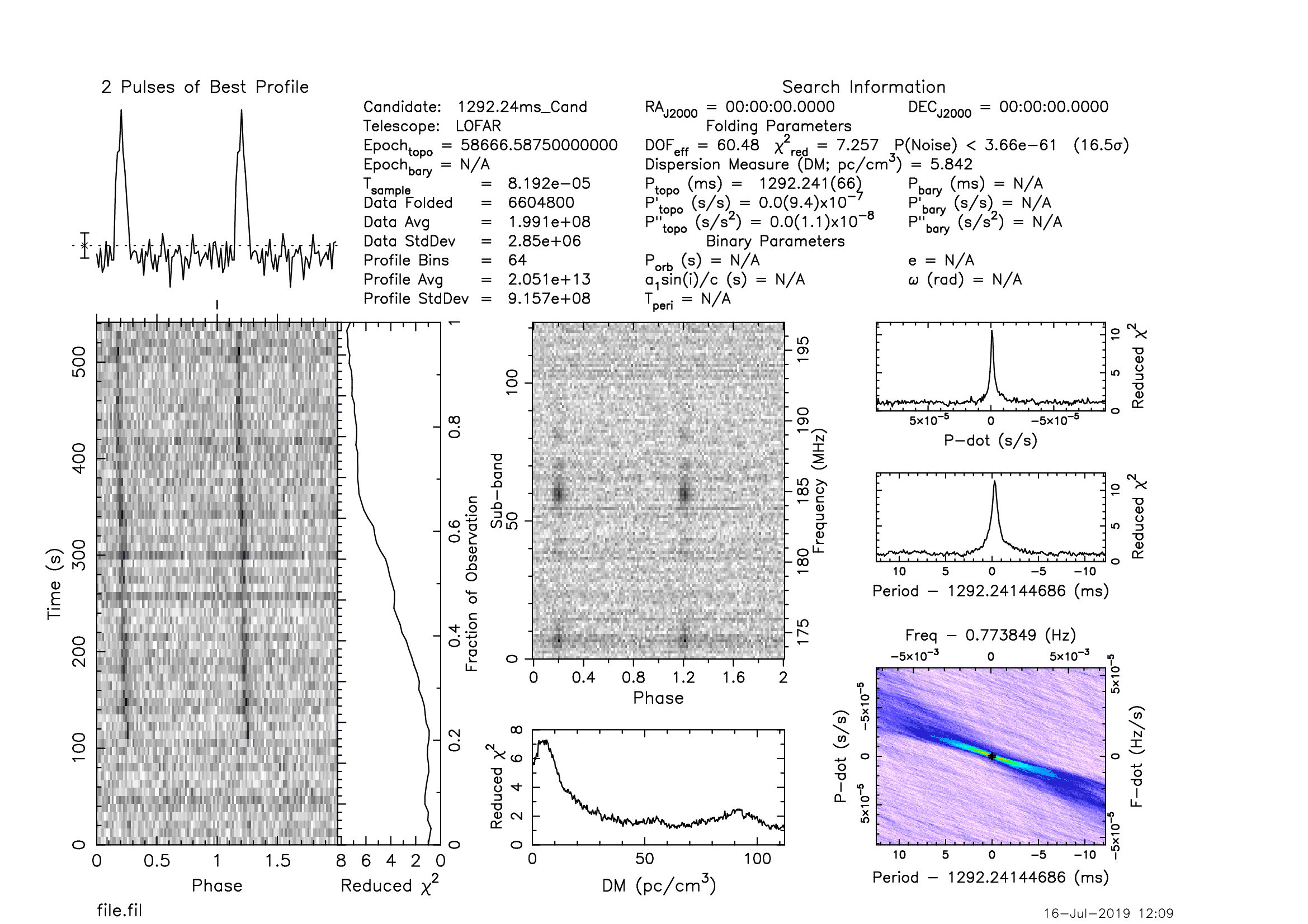
Plot of Pulsar B0809+74
Jane observed pulsar J105+5531 which has a period of 0.73968 seconds. This pulsar was also bright in radio and easy to detect, the resulting plots are below. All of our observations were made for ten minutes, plenty of time to detect the pulsars.
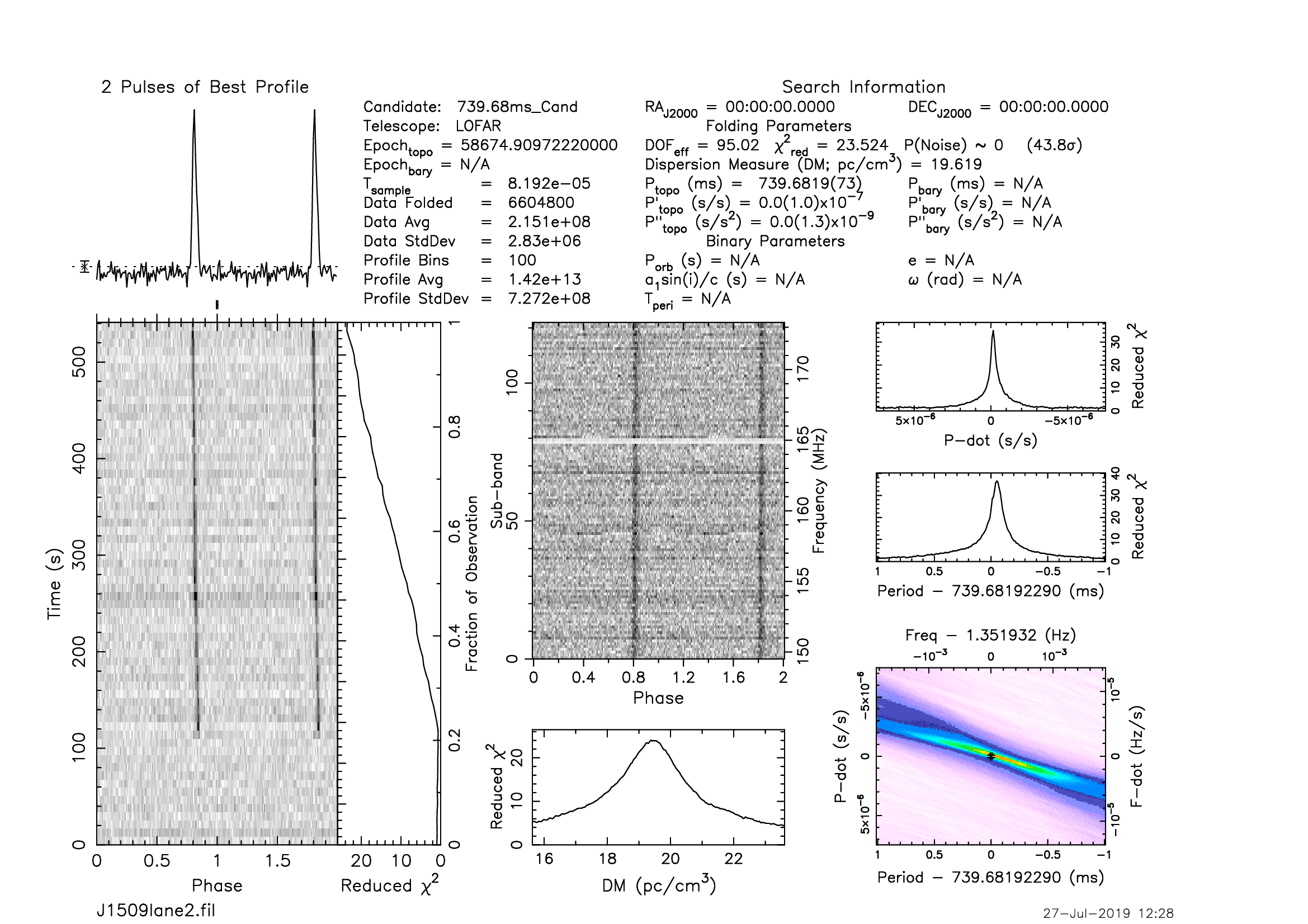
Pulsar J1509+5531 Plot
Observing with LOFAR was an excellent opportunity and being able to detect pulsars was very exciting! Jane and I gave 40 tours each over the summer, improving our confidence and public speaking skills, as well as our knowledge of the Leviathan, LOFAR and radio astronomy. We would like to sincerely thank Professor Peter Gallagher and Áine Flood for giving us the amazing opportunity to intern at the I-LOFAR Education Centre for the summer.
Blog post written by Jeremy Rigney.
Blog 6 – IAU100 and Ireland’s Involvement
/in blog /by Áine FloodLast week, we set up an exhibition here in Birr for the International Astronomical Union’s (IAU) 100th Anniversary. The exhibition is called Above and Beyond: Making Sense of the Universe for 100 Years. It details the major discoveries and events which have shaped astronomy since the IAU was established in 1919. It was launched here in Birr, in John’s Hall, on the evening of Thursday 8th August with some lovely words from Professor Tom Ray of DIAS. It will remain here and in the I-LOFAR Education Centre until Friday 16th August, before travelling onto Dublin with DIAS.
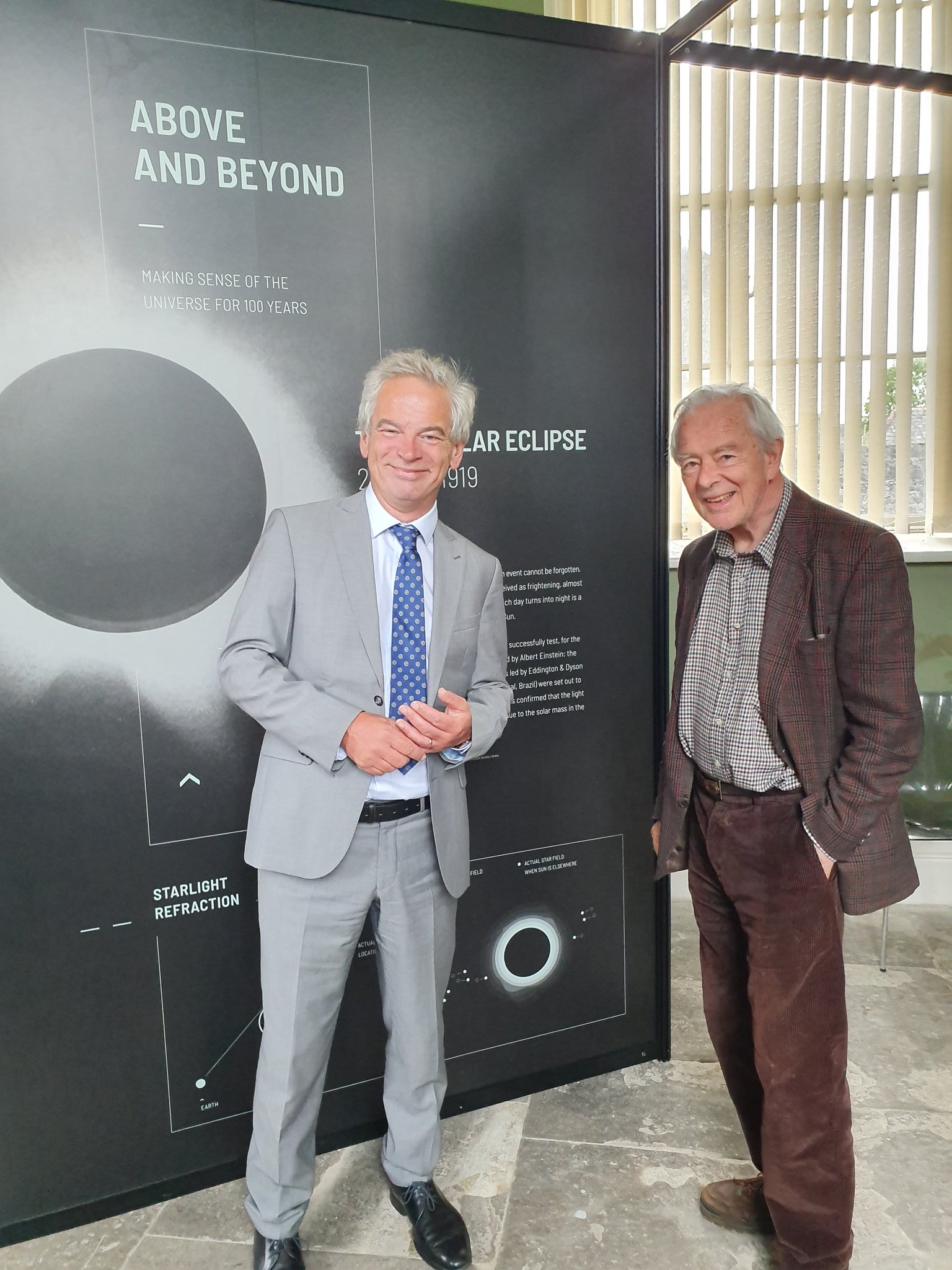
Professor Tom Ray and Lord Rosse at the IAU100 Exhibition in John’s Hall, Birr
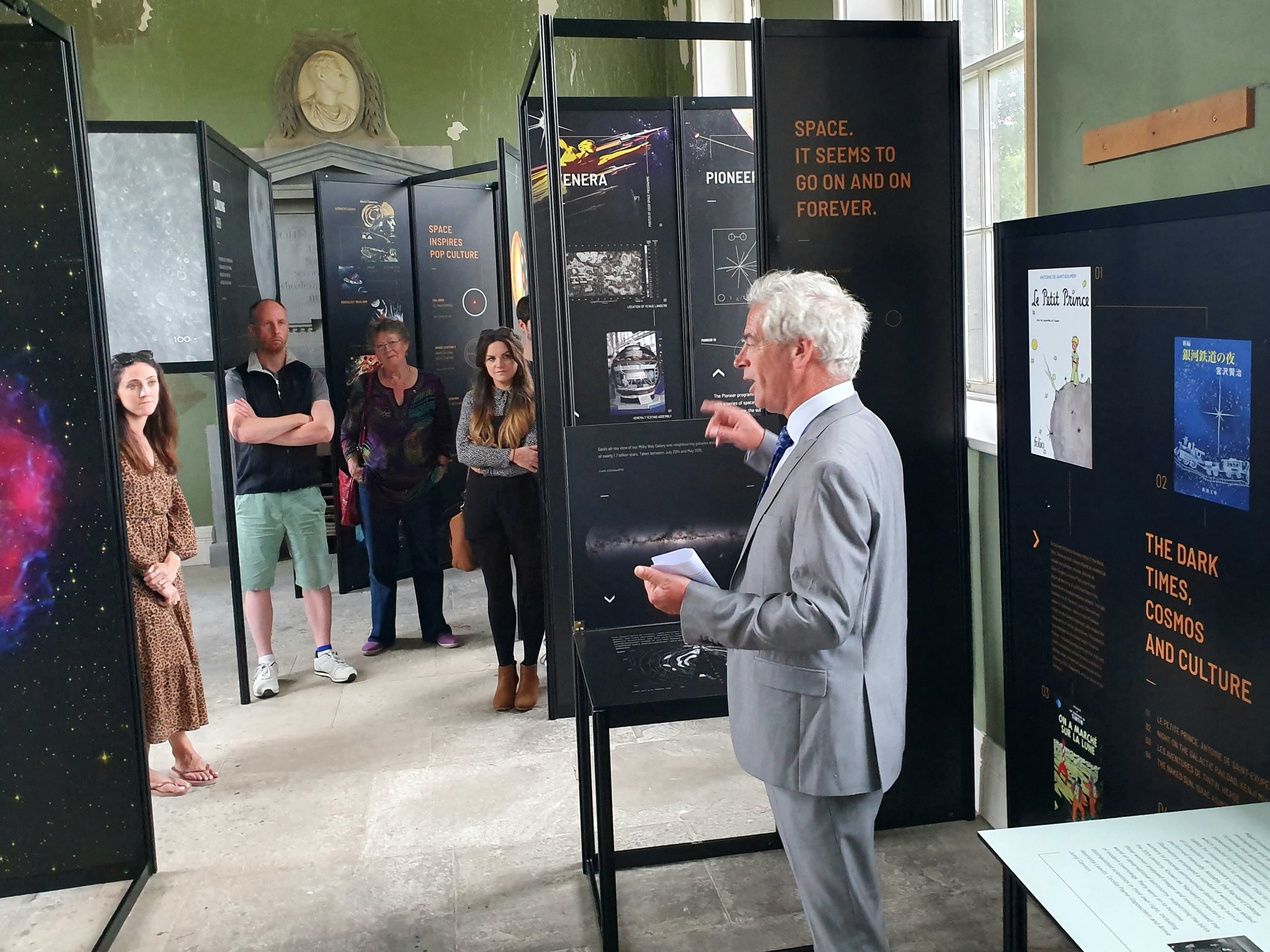
Professor Tom Ray speaking at the IAU100 Exhibition Launch in John’s Hall, Birr
Setting it up was a difficult process at first as there was only myself, Áine and Jeremy to do so, and some of the pieces are very large and awkward. We struggled through the first day alone, but luckily we got some help the next day with a visit from Eileen Flood from DIAS! Eileen and her husband kindly helped us get the last of the exhibition assembled and ready to go. As we set it up, it was a great opportunity to learn about how astronomy developed over the past century and really get a feel for Ireland’s role in this journey.

Since the start of the 20th Century, and indeed even long before that, Ireland has played an active role in discovering more about our Universe. In 1917, the Hooker Telescope in Mount Wilson Observatory, California, USA was constructed. This overtook the Leviathan Telescope here in Birr as the largest optical telescope in the world, with a mirror 2.5m in diameter and allowed for cutting edge astronomy that could view the Universe as it had never been seen before. Previous to this, in the 1840s and 1850s, the Third Earl of Rosse was the first person in the world to view what were known as “spiral nebulae”. Astronomers at the time didn’t know what these nebulae were. Some believed they were small and on the outskirts of our galaxy, the Milky Way, while others thought they were separate galaxies, large and very far away. This new idea, that there were galaxies other than our own, sparked a debate that raged on for decades and anyone who wanted to see these spiral nebulae for themselves, had to come to Birr to do so. Eventually, with the completion of the Hooker Telescope, Edwin Hubble was able to prove that many of these nebulae were much further away than the reach of the Milky Way. This was evidence that they were indeed other galaxies, and the question that started with the Third Earl of Rosse in Birr was settled.

The 3rd Earl of Rosse’s drawing of the Whirlpool Galaxy
On the 29th May 1919, a total solar eclipse occurred that was used to test Einstein’s Theory of General Relativity. The theory predicted that the light coming from stars around the Sun would be deflected due to the mass of the Sun. Two expeditions set out to test this, one led by Eddington and Dyson to an island off the coast of Africa, and another by Irish astronomer Andrew Crommelin to a town called Sobral in Brazil. Not only was one of these expeditions led by Crommelin from Co. Antrim, but the equipment used was Irish made. The Grubb Coelostat reflected light from the sky onto a fixed telescope and the Einstein Lens was used to focus the light onto a photographic plate. These pieces of equipment were both made by Howard Grubb, who was one of the most famous telescope makers in the world, from Rathmines in Dublin. The researchers confirmed that the light was deflected by the amount predicted by Einstein’s theory and Ireland was key to proving Einstein’s Theory of General Relativity.
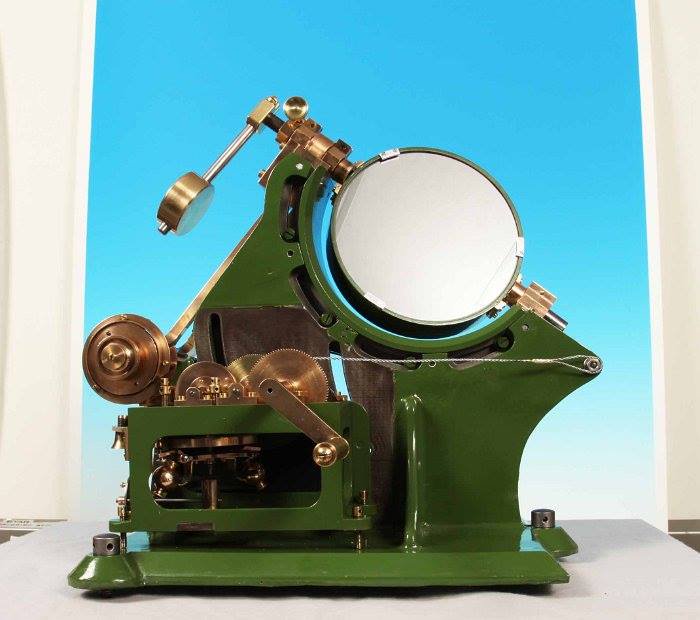
The Grubb Coelostat
In July 1967, Jocelyn Bell Burnell, who was then a PhD student at the University of Cambridge, detected some irregularities in her data while studying quasars. She had inadvertently discovered pulsars, which are rapidly rotating neutron stars that release jets of radiation from their poles. Professor Bell Burnell is from Lurgan in Co. Armagh and her major discovery has led to many developments in our understanding of the universe. Observations of a pulsar in a binary star system were used to confirm the existence of gravitational waves, the first exoplanet was discovered around a pulsar, and some pulsars are better than atomic clocks at keeping time!
Currently, I-LOFAR is located here in Birr and it is part of a european wide network of radio telescope arrays called LOFAR. LOFAR is the largest low frequency radio telescope in the world and once again Ireland is part of cutting edge research – keeping up a long tradition!
Blog post written by Jane Dooley.
Blog 5 – Space Workshops and Moon Landing Commemoration
/in blog /by Áine FloodThursday 18th and Saturday 20th of July brought Space Workshops to our Education Centre! Four sessions saw over 60 young people aged 7-14 learn about the moon and our place in the solar system. Topics ranged from the size and scale of the planets, to moon phases and crater creation. The workshops were organised to coincide with the 50th Anniversary of the Apollo 11 Moon Landing and were a great success. Workshops are now running every Friday at 2.30pm in the I-LOFAR Education Centre, starting from last Friday 26th of July, which saw even more young people learning about our place in the universe! The next workshop is on Friday 2nd August and is free for visitors in the castle grounds. Registration at the main reception in the courtyard is recommended.
Also on Saturday July 20th was the Birr Castle Moon Landing Projection on the wall of the Leviathan Telescope. With over 250 people in attendance it was an excellent opportunity to give tours of the history of astronomy at the Demesne. Between four tours Áine, Jane and I spoke to over 150 people, comparing 19th Century engineering at the Leviathan with the 21st Century technology of I-LOFAR. Unfortunately overcast skies meant public observations with the Midlands Astronomy Club optical telescopes were not possible, however the rain held off for the barbecue and projection. A musician set the tone for the evening barbecue in the courtyard, while the recently renovated Science Centre was open for attendees. Mary Field’s dark room, thought to be the oldest intact dark room in the world, now contains her ‘hologram’ speaking about her work as a pioneering photographer in the 1800s. Field was the wife of the Third Earl of Rosse, and they worked as a team to develop the science and engineering history that now exists at the castle. The moon landing projection conveyed the true challenge for the engineers and scientists at NASA to get men to the moon in 1969. President Kennedy’s famous ‘we choose to go to the moon’ speech was shown, along with the launch of the Saturn V rocket, and the moment Neil Armstrong first stepped on the moon.

Projection on the wall of the Leviathan Telescope

Space Camp – Balloon Planet making!
Keep an eye out for our next blog about the IAU 100 exhibit coming to Birr!
Blog post written by Jeremy Rigney, he can be found @jeremyrigney. Jane Dooley is also on twitter @JaneDooley98
Blog 4 – Armagh Observatory and Planetarium
/in blog /by Áine FloodOn Sunday 14th July the I-LOFAR Education team, Áine, Jeremy and I, visited Armagh Observatory and Planetarium to help them set up the International Astronomical Union’s 100th Anniversary Exhibition (IAU100). This exhibition is a journey through some of the most significant and surprising breakthroughs that shaped astronomy, technology and culture over the last century. The exhibition has been travelling around the world and is now here in Ireland for the next few months, starting with Armagh, until the 31st July. After that it is moving onto us here in Birr from Friday 9th to Friday 16th of August and will be displayed in Johns Hall and the I-LOFAR Education Centre. If you can’t make either of those, don’t worry because it will also be going to Dublin, Cork and Galway, so make sure you check it out!
In the early hours of Sunday morning, we began or journey to Armagh and got there just as the team at Armagh Observatory and Planetarium (AOP) were beginning set up of the part of the IAU100 exhibit that would be displayed at that venue. Luckily, they had experience with some of the other exhibition pieces and it didn’t take too long for us to get all the parts assembled and in place. The exhibit was really beautiful and informative and I would seriously recommend coming along to one of the venues and taking a look!
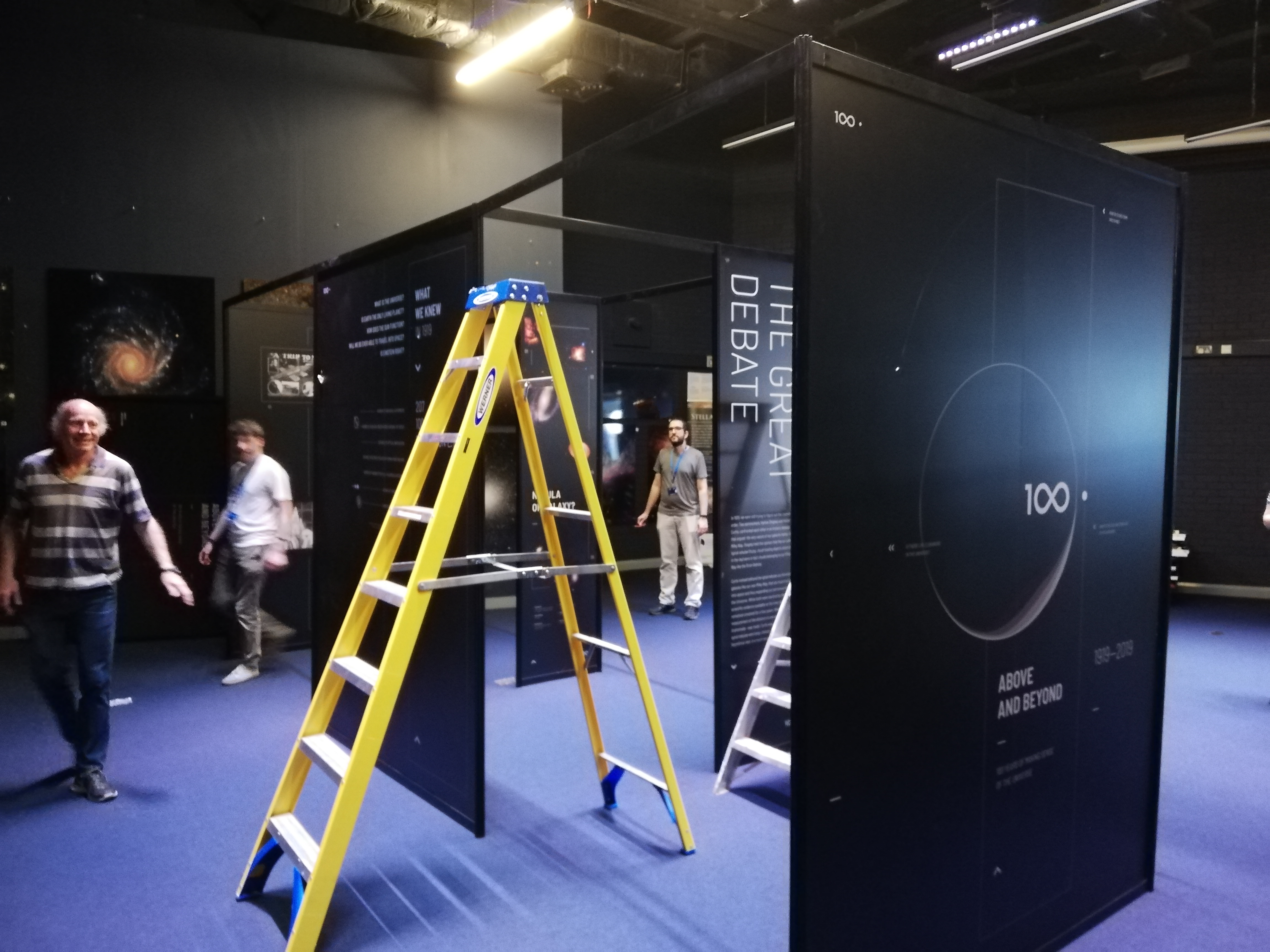

When it was all finished we were free to explore the planetarium, which had lots of fun things to do and see. After taking in all the beautiful models of satellites and rockets, and taking photos (playing) with the Astronaut props, we went up to the planetarium dome for a viewing of “Beyond the Blue: A Stargazing Journey”. The show was a beautiful guided tour of the night sky from Ireland during the Summer months, and we were able to lie back in our chairs and take in all the stars!

The Earth made from 250,000 pieces of Lego
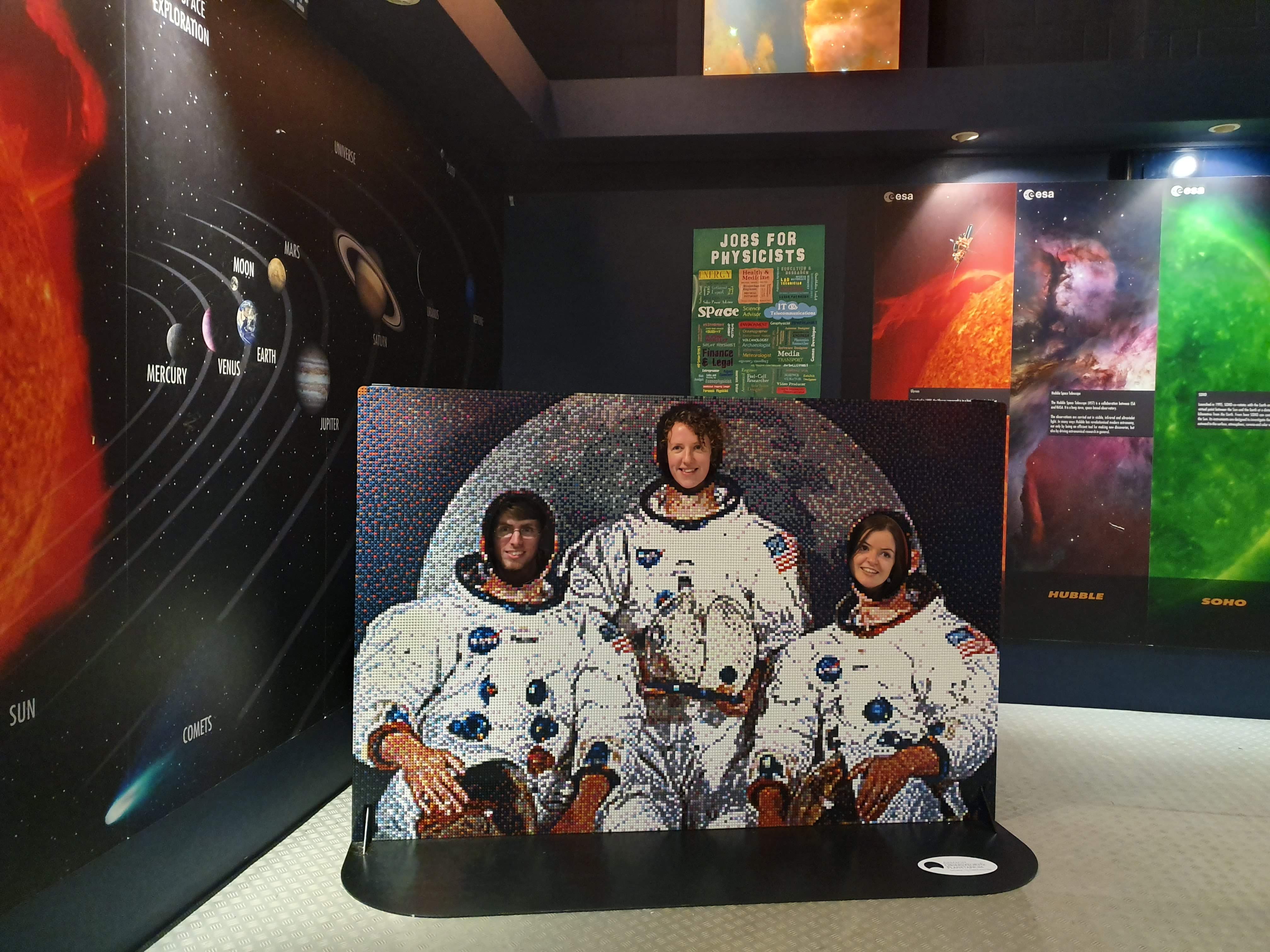
Neil Armstrong, Michael Collins and Buzz Aldrin (aka Jeremy, Áine and Jane)
After the movie the director of AOP, Prof. Michael Burton, gave us a tour of their Astropark, built in 1994. They had a scale model of the solar system, and even a scale model of the universe in logarithmic space called the “Hill of Infinity”! There were also many other features, such as a stone circle to see where the sun sets at different times of the year, a human sundial and a human orrery to model the paths of the planets. Then we were told all about the history of Armagh Observatory and shown a handful of the numerous telescopes the Observatory houses.
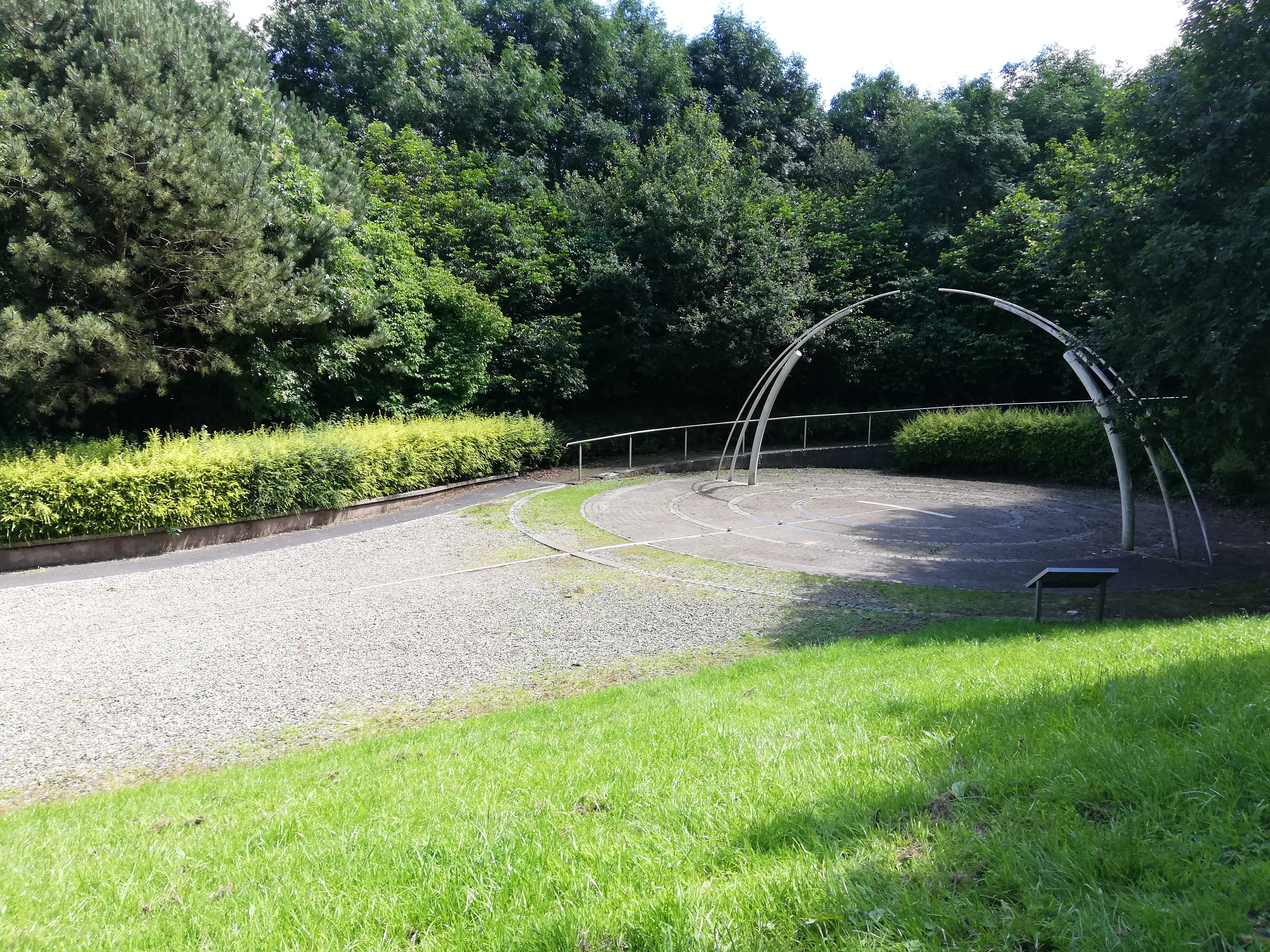
The Sun- part of the scale model of The Solar System in the Astropark

A stop on the “Hill of Infinity”
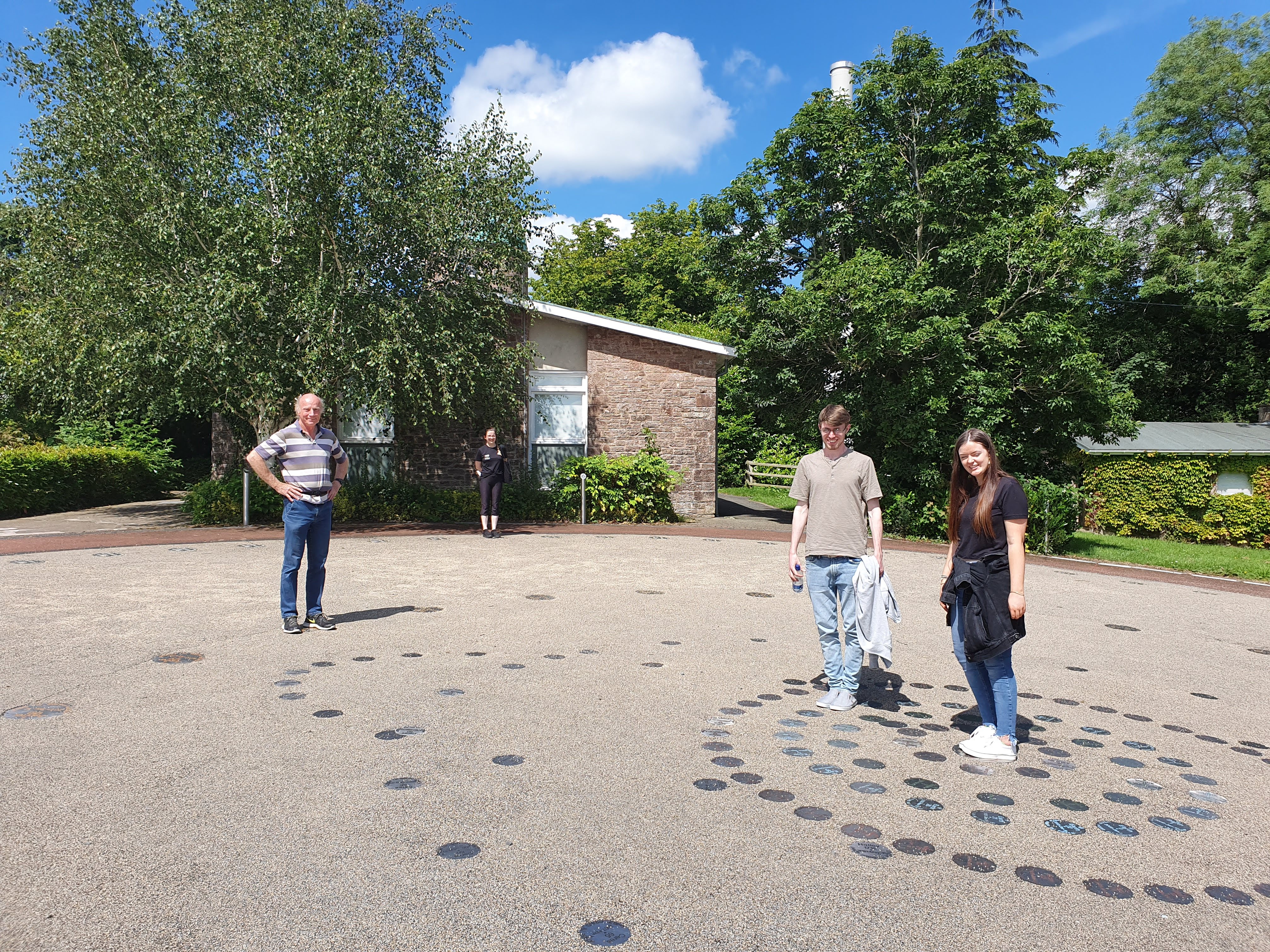
The human orrery at Armagh Observatory and Planetarium
Armagh Observatory was founded in 1789 by Richard Robinson, Archbishop of Armagh and the Planetarium was opened in 1968 through the efforts of Director Eric Lindsay. The observatory was the second to be established in Ireland (the first being Dunsink where we visited the week before) and is the oldest scientific institution in Northern Ireland. It houses a number of old telescopes and observing domes, such as the Troughton Equatorial Telescope and the 15 Inch Grubb Refractor. The oldest telescope in the world still in its original position is in Armagh Observatory! The third director of the Observatory, Thomas Romney Robinson, invented the cup anemometer, used to measure wind speed. He remained director for 59 years and which is a world record for an observatory director that stands today. He was succeeded by J.L.E. Dreyer, who had previously been assistant astronomer at Birr Castle and compiled the “New General Catalogue of Nebulae and Clusters of Stars” (or NGC catalogue). It remains to this day the principal catalogue of nebulae and galaxies used by astronomers worldwide.
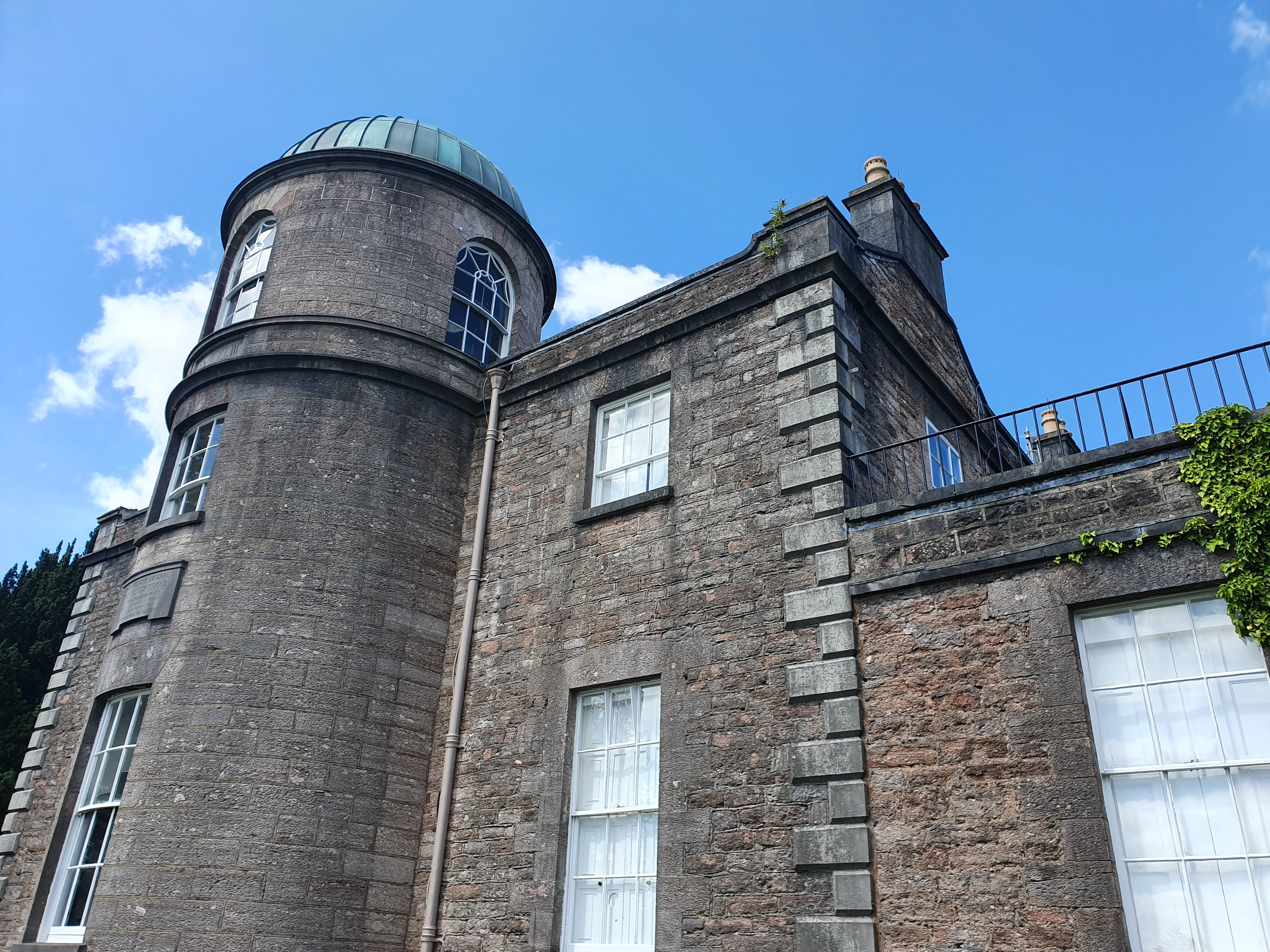
After the interesting history lesson and tour we headed into Armagh city and got some well-earned food. When we were as full as possible, we had a look at some of the other locations the IAU100 Exhibition is being displayed in around Armagh and then headed for home!
Armagh Observatory and Planetarium was an excellent day out with lots of unique things to do and see, which I would highly recommend. We are now very excited here in Birr for the IAU100 Exhibition to be passed onto us. Make sure you come visit us at Johns Hall and the I-LOFAR Education Centre between 9th and 16th of August. Birr Vintage Week and Arts Festival will also be taking place from the 2nd to the 10th of August, so make sure to check it all out!
Blog Post written by Jane Dooley. Jeremy Rigney and Áine Flood can be found at @jeremyrigney and @AineFlood1 respectively.
Blog 3 – DIAS and Dunsink!
/in blog /by Áine FloodThis week Jane and I are continuing to develop exhibits for the I-LOFAR Education Centre, creating posters and interactive elements to display for the public. Tour numbers have increased as Birr Castle reaches its summer peak, and a large number of people have booked for the 50th Anniversary of the Moon Landing ‘Star-B-Q’ at Birr Castle on Saturday the 20th of July! We’re also currently planning drop in workshops for young people on Thursday the 18th and Saturday the 20th of July.
On Wednesday we visited the Dublin Institute for Advanced Studies (DIAS) Astronomy and Astrophysics Department in Fitzwilliam Place in Dublin to attend a talk given by the Director of the Atacama Large Millimeter Array (ALMA), Dr. Sean Dougherty. ALMA is one of the world’s largest and most powerful telescopes, located in the Atacama Desert, Chile. The main array consists fifty 12 meter diameter dishes using interferometry (the same technology used in LOFAR) to act as one giant dish. There are another sixteen dishes at the site, four of which are 12 meters in diameter and the remaining twelve with 7 meter diameters. The dishes can be concentrated in a 150 meter area or moved apart to create a baseline of 16 km. They observe the universe in the millimeter and sub-millimeter wavelengths of light, in search of the formation of galaxies in the early universe and exoplanet formation around distant stars. (LOFAR in comparison observes in meter wavelengths)

DIAS – Director of ALMA talk. Credit DIAS Astronomy and Astrophysics
After the Director’s talk we visited Dunsink Observatory. The Observatory was constructed in 1785 using money left by the provost of Trinity College Dublin Francis Andrews in his will. It was run for a time by William Rowan Hamilton, the famous mathematician who developed Hamiltonian Mechanics and Quaternions (which are used in 3D Graphics). Many astronomers used the telescope to observe the night skies until Dublin expanded around it and light pollution reduced its visibility. The site was the first in Ireland to be given the title ‘European site of historical significance’ by the European Physical Society in recognition of its history. Today it is run by DIAS and is being refurbished. The large room that once housed the transit circle used to calculate ‘Dunsink Time’ (and hence ‘Dublin time’) now hosts open nights for the public. There are two domes visible at the observatory. The one on the roof of the building housed a smaller telescope said to be used by Hamilton’s students. It is now replaced with a modern refracting telescope. The large ‘South Dome’ on the front lawn houses the original 12 inch refracting telescope. We met some of the summer interns at DIAS who are in the process of creating a museum on the ground floor for the public and they gave us a tour of the incredible artefacts and history within the observatory.

DIAS Front Door Plaque
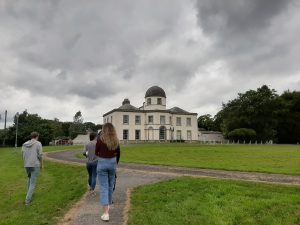
Dunsink Observatory
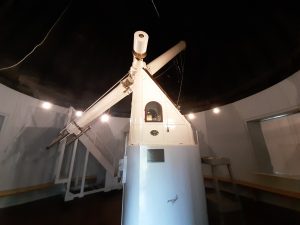
12 Inch Refracting Telescope in South Dome Dunsink
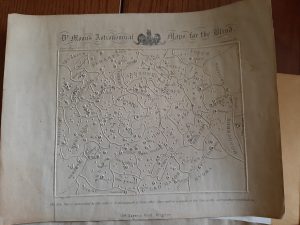
Star Map for the Blind at Dunsink Observatory
Jane and I are taking a road trip to Armagh this weekend to visit Armagh Observatory and Planetarium and the IAU 100 Exhibit so keep an eye out for our next blog!
Blog post written by Jeremy, you can find him on Twitter @jeremy.rigney. Jane is also on Twitter, find her @JaneDooley98
Blog 2 – Observing, Camps and Exhibits
/in blog /by Áine FloodThis week Jeremy and I have been finalising preparations for Space Camp 2019, a summer camp for 8-12 year olds run by I-LOFAR and Birr Castle. It will take place over four days from the 15th to the 18th of July and we are really looking forward to it! This has involved lots of arts and crafts, like making planets out of balloons and rice, and cutting up cardboard to make models of the Earth-Sun-Moon orbit. It makes us feel like big children!
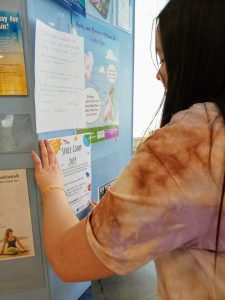
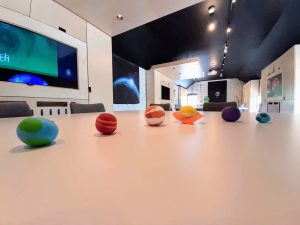
Planets made from rice and balloons!
We have also been planning exhibit pieces to be displayed in the Education Centre here at I-LOFAR to showcase what we do and how radio astronomy works. These include topics such as RFI (Radio Frequency Interference), the electromagnetic (EM) and atmospheric absorption spectrums, and the Drake Equation.
RFI in radio astronomy is any source of transmission that is within the observed frequency band, other than the celestial sources being observed. Signals from Earth can be much stronger that the signals of interest as they are so much closer, so RFI is a major issue when performing radio astronomy. RFI can be caused by a number of things, like manmade transmitters or natural phenomena such as lightning. To be able to able to observe with LOFAR at high sensitivities, RFI needs to be accurately detected.
The EM spectrum is the range of frequencies and wavelengths of EM radiation. The radio section of the EM spectrum encompasses a much wider range of wavelengths than the visible, and those are the only two types of EM waves that can pass through the Earth’s atmosphere. This means the only types of astronomy that can be conducted from the ground are radio and optical. Others such as x-ray and gamma ray astronomy have to be performed high up the mountains or in space. You could say that LOFAR is very down to Earth!
The Drake Equation estimates the number of technological civilisations that may exist in our galaxy. There is no unique solution to this equation, but it summarises the concepts which must be considered when questioning the existence of communicative extraterrestrial life. I-LOFAR may be used to assist in the Search for Extraterrestrial Intelligence (SETI) in collaboration with the Breakthrough Listen foundation.
This week Jeremy and I got to make observations with I-LOFAR! I was able to observe the Crab Pulsar for 10 minutes and Jeremy looked at two bright millisecond pulsars. We used the new REALTA (REALtime Transient Acquisition Cluster) system, which gives us millisecond time resolution in our observations. We are looking forward to analysing this data in the coming weeks, hopefully we’ll be able to detect the pulses!
Of course, we are still giving daily astronomy tours from the Leviathan to I-LOFAR and these have been getting quite busy! It’s great to see so many people interested and asking questions. We also had a few canine visitors to add our #DogsofILOFAR, keep an eye out on our Twitter and Instagram for pictures! We have added an extra tour on Saturdays. They now take place at 13:30 Monday -Friday, and at 12:00 and 15:00 Saturday!

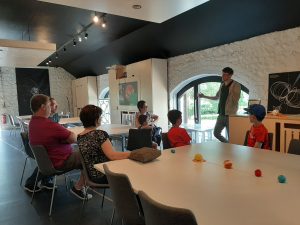
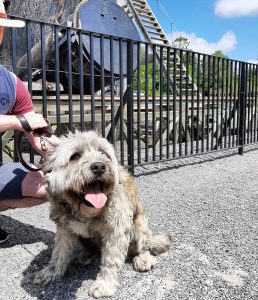
Next Wednesday we will be visiting DIAS and Dunsink observatory in Dublin, we are really excited! Make sure to check back next week for our blog post about this.
Blog post written by Jane, you can find her on Twitter @JaneDooley98. Jeremy is also on twitter, find him @jeremy.rigney
Blog One – Intern Intro!
/in blog /by Áine FloodHello World, Jeremy and Jane here, we’re interns at the I-LOFAR Education Centre for the Summer! Both of us are undergraduate astrophysics students at UCD and UCC respectively. We’re helping Áine (@aineflood1) create the Education and Public Engagement Programme for the station to promote Astronomy to the public and young people in the midlands.

Jane and Jeremy, I-LOFAR Summer Interns
What is I-LOFAR?
The Irish Low Frequency Array (or I-LOFAR) is a radio telescope located in Birr, Co. Offaly. It is one of 52 stations located across Europe which when connected form the European LOFAR Network. All stations consist of two arrays, low band, operating in the frequency range 10-90 MHz, and high band, observing from 110-240 MHz. The gap in frequencies is due to the presence of the FM radio band, which blocks the weak incoming signals from the universe in that range.
How does it work?
LOFAR isn’t your typical radio telescope. While the majority of radio telescopes rely on large concave movable dishes to observe, LOFAR is different. It’s a software telescope, which means its stationary arrays of antenna rely on software to create beams to ‘point’ at astronomical objects. I-LOFAR is used to observe the Sun, pulsars, and much more!
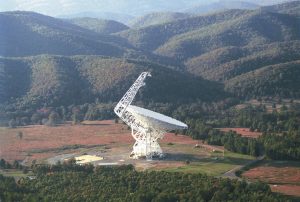
Image of Greenbank Radio Telescope, one of the previous generation of rotating dish radio telescopes. LOFAR is the beginning of a new generation of ‘software radio telescopes’.

The Irish LOFAR radio telescope at Birr Castle, Co. Offaly, Ireland. Credit: Alison Delaney, Birr Castle.
Ok, what are you guys doing?
Jane and I are planning the schedules for the I-LOFAR and Birr Castle Summer Space Camps 2019. The week-long camps will run from the 15th-18th of July for ages 8-12, and the 12th to 16th of August for ages 14-16. We’re also giving daily Astronomy in Birr tours from the Leviathan Telescope (constructed in 1845) to I-LOFAR (constructed in 2017), showing the timeline of astronomy in Birr Castle over the last 170 years. The I-LOFAR Education Centre opened recently and has space for several exhibits in the planning stage, ideas are welcome!
Sounds cool, so can I visit LOFAR?
Yes, of course! Once you are on the grounds of Birr Castle you can come up to the I-LOFAR Education Centre where Jane or myself would be happy to tell you about the station. Our tours are running Monday-Saturday at 1.30pm throughout the summer. Each day we start at the Leviathan so feel free to come along!
We also hope to begin making our own observations with I-LOFAR in the coming weeks, so stay tuned to hear how we get on!
Blog post written by Jeremy Rigney, you can find him on Twitter @jeremy.rigney. Jane Dooley is also on twitter, find her at @JaneDooley98

